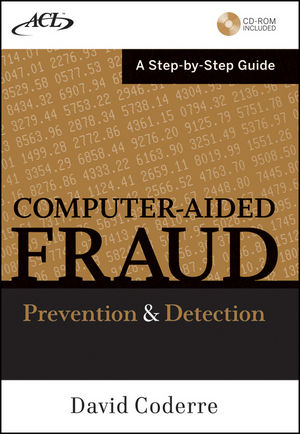Computer Aided Fraud Prevention and Detection: A Step by Step GuideISBN: 978-0-470-39243-0
Hardcover
304 pages
March 2009
 This is a Print-on-Demand title. It will be printed specifically to fill your order. Please allow an additional 10-15 days delivery time. The book is not returnable.
|
||||||
Preface.
CHAPTER 1: What Is Fraud?
Fraud: A Definition.
Why Fraud Happens.
Who Is Responsible for Fraud Detection?
What Is a Fraud Awareness Program?
Screening Job Applicants.
What Is a Corporate Fraud Policy?
Notes.
CHAPTER 2: Fraud Prevention and Detection.
Detecting Fraud.
Determining the Exposure to Fraud.
Assessing the Risk that Fraud Is Occurring (or Will Occur).
External Symptoms.
Identifying Areas of High Risk for Fraud.
Looking at the Exposures from the Fraudster’s Perspective.
Approach 1: Control Weaknesses.
Who Could Benefit from the Identified Control Weaknesses?
What Can They Influence, Control, or Affect?
Can They Act Alone or Is Collusion Required?
Approach 2: Key Fields.
Which Data Fields Can Be Manipulated and by Whom?
Additional Fraud Risk Considerations.
Understanding the Symptoms of Fraud.
Being Alert to the Symptoms of Fraud.
Building Programs to Look for Symptoms.
Investigating and Reporting Instances of Fraud.
Implementing Controls for Fraud Prevention.
Notes.
CHAPTER 3: Why Use Data Analysis to Detect Fraud?
Increased Reliance on Computers.
Developing CAATTs Capabilities.
Integrated Analysis and Value-Added Audit.
Recognizing Opportunities for CAATTs.
Developing a Fraud Investigation Plan.
Allegation.
Objective.
Audit Team.
Schedule.
Data Source.
Analysis.
Legal Authority.
Notes.
CHAPTER 4: Solving the Data Problem.
Setting Audit Objectives.
Defining the Information Requirements.
Accessing Data.
Data Paths.
Data File Attributes and Structures.
Assessing Data Integrity.
Overview of the Application System.
Overview of the Data.
Notes.
CHAPTER 5: Understanding the Data.
Computer Analysis.
Analysis Techniques.
Filter/Display Criteria.
Expressions/Equations.
Gaps.
Statistical Analysis.
Duplicates.
Sort/Index.
Summarization.
Stratification.
Cross Tabulation/Pivot Tables.
Aging.
Join/Relate.
Trend Analysis.
Regression Analysis.
Parallel Simulation.
Benford’s Law.
Digital Analysis.
Confirmation Letters.
Sampling.
Combining Techniques.
Assessing the Completeness of the Data.
Filter or Display Criteria.
Expression/Equation.
Gaps.
Statistical Analysis.
Duplicates.
Sorting and Indexing.
Notes.
CHAPTER 6: Overview of the Data.
Summarization.
Stratification.
Cross Tabulation/Pivot Tables.
CHAPTER 7: Working with the Data.
Aging.
Join/Relation.
CHAPTER 8: Analyzing Trends in the Data.
Trend Analysis.
Regression Analysis.
Parallel Simulation.
Notes.
CHAPTER 9: Known Symptoms of Fraud.
Known and Unknown Symptoms.
Fraud in the Payroll Area.
Ghost Employees.
Terminated Employees.
Overpayment.
Fraud in the Purchasing Area.
Employee Activities.
Vendor Action and Employee Inaction.
Collusion between Vendor and Employee.
Symptoms of Purchasing Fraud.
Kickbacks.
Fixed Bidding.
Goods Not Received.
Duplicate Invoices.
Inflated Prices.
Inferior Quality.
Excess Quantities.
CHAPTER 10: Unknown Symptoms of Fraud.
(Using Digital Analysis).
Data Profiling.
Statistical Analysis.
Stratification.
Frequently Used Values.
Even Amounts and Rounding.
Least/Most Used Categories.
Ratio/Variance Analysis.
Maximum/Minimum.
Maximum/Second Highest.
Current/Previous.
One Business Area/Another.
Benford's Law.
Notes.
CHAPTER 11: Automating the Detection Process.
Fraud Applications or Templates.
Fraud Application Development.
CHAPTER 12: Verifying the Results.
Confirmation Letters.
Sampling.
Judgmental or Directed Sampling.
Statistical Sampling.
Quality Assurance.
Quality Assurance Methodology.
Preventive Controls.
Detective Controls.
Corrective Controls.
Ensuring Reliability.
Data Analysis and Prosecuting Fraud.
Notes.
APPENDIX 1: Fraud Investigation Plans.
Insurance Policies—Too Good to Be True.
Paid by the Numbers.
APPENDIX 2: Application of CAATTs by Functional Area.
Accounts Receivable Tests.
Accounts Payable Tests.
General Ledger Tests.
Materials Management and Inventory Control Tests.
Salary and Payroll Tests.
Purchase Order Management Tests.
Conflict-of-Interest Tests.
Kickback Tests.
Bid-Rigging Tests.
Policy and Administration Tests.
Vendor Management Tests.
Retail Loss Prevention Tests.
Sales Analysis Tests.
Work in Progress Tests.
Cash Disbursement Tests.
Customer Service Management Tests.
Loan Tests.
Deposit Tests.
Real Estate Loans.
Credit Card Management.
Life Insurance Tests.
Travel Claims.
APPENDIX 3: ACL Installation Process.
Epilogue.
References.
Index.



